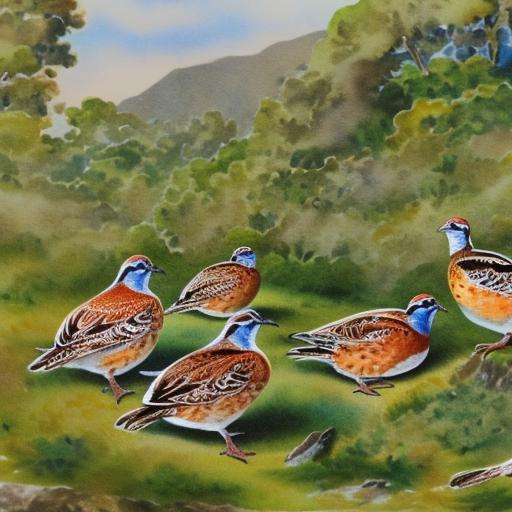Quails are small, ground-dwelling birds that belong to the pheasant family. They are known for their delicious eggs and meat, as well as their charming appearance. There are many different quail breeds, each with its own unique characteristics and uses. Quail breeds can be categorized into three main groups: those bred for egg production, those bred for meat production, and ornamental breeds. Each type of quail breed has specific traits that make them suitable for different purposes. Whether you are interested in raising quails for their eggs, meat, or simply as pets, there is a breed that will meet your needs.
Quails are popular among poultry enthusiasts for their small size, low maintenance requirements, and high productivity. They are also known for their adaptability to various climates and their ability to thrive in both indoor and outdoor settings. With the right knowledge and care, quails can be a rewarding addition to any farm or backyard. In this article, we will explore the characteristics of different quail breeds, popular quail breeds for egg production, quail breeds for meat production, ornamental quail breeds, rare and endangered quail breeds, and how to select the right quail breed for your specific needs.
Key Takeaways
- There are many different quail breeds, each with their own unique characteristics and purposes.
- Quail breeds can vary in size, color, and egg production capabilities.
- Popular quail breeds for egg production include Coturnix, Bobwhite, and California quail.
- Quail breeds for meat production include Jumbo Coturnix and Italian quail.
- Ornamental quail breeds, such as Chinese Painted and Blue Scale quail, are valued for their attractive appearance.
- Rare and endangered quail breeds, like the Himalayan and Japanese quail, require special attention for conservation efforts.
- When selecting a quail breed, consider your specific needs for egg or meat production, as well as the availability and conservation status of the breed.
Characteristics of Different Quail Breeds
Quail breeds come in a variety of sizes, colors, and patterns. Some breeds are known for their prolific egg-laying abilities, while others are prized for their flavorful meat. Additionally, there are ornamental quail breeds that are valued for their unique and attractive plumage. When choosing a quail breed, it is important to consider factors such as egg production, meat quality, temperament, and overall suitability for your specific needs.
Some common quail breeds include the Coturnix quail, also known as the Japanese quail, which is one of the most popular breeds for both egg and meat production. They come in a variety of colors and are known for their high egg production and fast growth rate. Another popular breed is the Bobwhite quail, which is native to North America and is prized for its delicious meat. The Bobwhite quail is also a popular game bird and is often raised for hunting purposes. Other popular quail breeds include the California quail, Gambel’s quail, and the Button quail, which is a small ornamental breed known for its colorful plumage.
In addition to these popular breeds, there are also rare and endangered quail breeds that are in need of conservation efforts to ensure their survival. These breeds often have unique characteristics and historical significance, making them valuable additions to any conservation program. Overall, the characteristics of different quail breeds vary widely, and it is important to research each breed thoroughly before making a decision on which one is best suited for your specific needs.
Popular Quail Breeds for Egg Production
When it comes to egg production, the Coturnix quail is one of the most popular breeds among poultry enthusiasts. They are known for their prolific egg-laying abilities, with some hens laying up to 300 eggs per year. Coturnix quails come in a variety of colors, including brown, white, and speckled, making them an attractive addition to any flock. They are also known for their fast growth rate, reaching maturity in just 6-8 weeks.
Another popular breed for egg production is the Bobwhite quail. While not as prolific as the Coturnix quail, Bobwhite hens still lay a respectable number of eggs each year. Their eggs are slightly larger than those of the Coturnix quail and have a rich flavor that is prized by many poultry enthusiasts. In addition to these two breeds, there are also other quail breeds that are valued for their egg-laying abilities, such as the California quail and Gambel’s quail.
When selecting a quail breed for egg production, it is important to consider factors such as egg size, color, and flavor, as well as the overall productivity of the breed. Additionally, it is important to provide proper housing, nutrition, and care to ensure that your quails reach their full egg-laying potential. With the right breed and proper management, quails can be a valuable source of fresh eggs for your family or business.
Quail Breeds for Meat Production
Quails are also valued for their flavorful meat, making them a popular choice for meat production. The Coturnix quail is one of the most popular breeds for meat production due to its fast growth rate and high meat-to-bone ratio. Coturnix quails reach maturity in just 6-8 weeks and have tender, flavorful meat that is prized by chefs and home cooks alike. Their small size also makes them easy to process and prepare for consumption.
In addition to the Coturnix quail, the Bobwhite quail is also valued for its delicious meat. While not as fast-growing as the Coturnix quail, Bobwhite quails have a rich flavor that is highly sought after by those who appreciate gourmet game meats. Their slightly larger size also makes them a good choice for those looking for a larger bird for meat production.
When raising quails for meat production, it is important to provide them with a balanced diet and proper living conditions to ensure that they reach their full growth potential. Additionally, it is important to handle and process the birds humanely to ensure the quality of the meat. With the right breed and proper management, quails can be a valuable source of lean, flavorful meat for your family or business.
Ornamental Quail Breeds
In addition to their practical uses for egg and meat production, some quail breeds are valued primarily for their ornamental qualities. These breeds are often kept as pets or raised for exhibition purposes due to their unique and attractive plumage. One popular ornamental quail breed is the Button quail, which comes in a variety of colors and patterns, including silver, cinnamon, and pearl. Button quails are small in size and have charming personalities, making them a favorite among bird enthusiasts.
Another ornamental quail breed is the California quail, which is known for its striking plumage and distinctive topknot. California quails are native to the western United States and are often kept in aviaries or as part of breeding programs aimed at conserving this beautiful species. In addition to these two breeds, there are also other ornamental quail breeds that are valued for their unique appearance and charming personalities.
When keeping ornamental quails, it is important to provide them with proper housing and enrichment to ensure their health and well-being. Additionally, it is important to research each breed thoroughly to understand their specific care requirements and ensure that they are suitable for your specific needs. With the right breed and proper care, ornamental quails can be a delightful addition to any aviary or backyard flock.
Rare and Endangered Quail Breeds

While some quail breeds are popular and widely available, there are also rare and endangered quail breeds that are in need of conservation efforts to ensure their survival. These breeds often have unique characteristics and historical significance, making them valuable additions to any conservation program. One example of a rare and endangered quail breed is the Himalayan Quail, which is native to India and has not been seen in the wild since 1876.
Another rare and endangered quail breed is the Blue Quail, also known as the King Quail or Chinese Painted Quail. This small bird is native to Southeast Asia and has become increasingly rare due to habitat loss and overhunting. Efforts are underway to conserve this beautiful species through captive breeding programs and habitat restoration initiatives.
In addition to these two examples, there are many other rare and endangered quail breeds around the world that are in need of conservation efforts to ensure their survival. By supporting conservation programs and raising awareness about these rare breeds, we can help ensure that they continue to thrive for future generations to enjoy.
Selecting the Right Quail Breed for Your Needs
When selecting a quail breed for your specific needs, it is important to consider factors such as egg production, meat quality, temperament, and overall suitability for your specific goals. If you are primarily interested in raising quails for their eggs, then breeds such as the Coturnix quail or Bobwhite quail may be good choices due to their prolific egg-laying abilities. On the other hand, if you are interested in raising quails for meat production, then breeds such as the Coturnix quail or Bobwhite quail may be good choices due to their fast growth rate and flavorful meat.
If you are interested in keeping ornamental quails as pets or for exhibition purposes, then breeds such as the Button quail or California quail may be good choices due to their unique appearance and charming personalities. Additionally, if you are interested in supporting conservation efforts for rare and endangered quail breeds, then researching and supporting conservation programs aimed at preserving these valuable species may be a meaningful way to contribute to their survival.
Overall, selecting the right quail breed for your specific needs requires careful consideration of factors such as egg production, meat quality, temperament, and overall suitability for your goals. By researching each breed thoroughly and understanding their specific characteristics and care requirements, you can make an informed decision on which breed is best suited for your specific needs. Whether you are interested in raising quails for eggs, meat, ornamental purposes, or conservation efforts, there is a breed that will meet your needs with proper care and management.
If you’re considering raising quails, it’s important to understand the different breeds and their unique characteristics. Whether you’re converting a shed into a quail coop, looking for a portable coop solution, or exploring options for a larger coop in Grand Island, NE, Poultry Wizard has you covered. Check out their article on “The Best Quail Breeds for Your Chicken Coop” to learn more about the various breeds and find the perfect fit for your setup. Read more here.
FAQs
What are the different quail breeds?
There are several different quail breeds, including the Coturnix quail, Bobwhite quail, Gambel’s quail, California quail, and Mountain quail.
What are the characteristics of Coturnix quail?
Coturnix quail are known for their small size, fast growth rate, and high egg production. They come in a variety of colors, including brown, white, and speckled.
What are the characteristics of Bobwhite quail?
Bobwhite quail are native to North America and are known for their distinctive call. They are popular game birds and are often raised for hunting purposes.
What are the characteristics of Gambel’s quail?
Gambel’s quail are found in the southwestern United States and are known for their striking plumage and distinctive topknot. They are often found in desert habitats.
What are the characteristics of California quail?
California quail are known for their bold and striking plumage, with a distinctive teardrop-shaped crest on their heads. They are found in the western United States and are popular game birds.
What are the characteristics of Mountain quail?
Mountain quail are found in the western United States and are known for their shy and elusive nature. They have a unique call and are often found in mountainous habitats.
Meet Walter, the feathered-friend fanatic of Florida! Nestled in the sunshine state, Walter struts through life with his feathered companions, clucking his way to happiness. With a coop that’s fancier than a five-star hotel, he’s the Don Juan of the chicken world. When he’s not teaching his hens to do the cha-cha, you’ll find him in a heated debate with his prized rooster, Sir Clucks-a-Lot. Walter’s poultry passion is no yolk; he’s the sunny-side-up guy you never knew you needed in your flock of friends!







